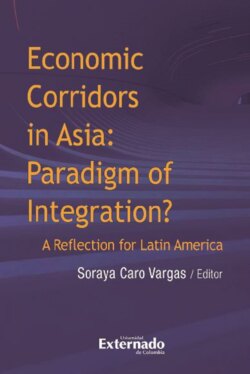Читать книгу Economic corridors in Asia : paradigm of integration? A reflection for Latin America - Varios autores - Страница 39
На сайте Литреса книга снята с продажи.
9. TRANSPORT CORRIDORS –BBIN AND BCIM INITIATIVE
ОглавлениеDuring his visit to China in May 2015, Prime Minister Modi referred to BCIM as one of the important areas of convergence between India and China and it was also reflected in the Joint Communiqué between the two leaders. Modi has been in favour of opening the BCIM corridor for the benefit of India and the participating countries. However, the sectors and the areas which would be open for cooperation between the four countries would be decided and steered by consensus and dialogue. BCIM is expected to open the trade route, particularly the land route, for India to reach out to its northeastern neighbors and Myanmar. With full implementation of the BBIN (Bangladesh, Bhutan, India and Nepal) transport corridor where the motor vehicle arrangement is seen as a successful homogenization and standardization of motor vehicles, driver licenses and improvement in transport infrastructure. Both these regions (BBIN and BCIM) are critically important for India to generate economic growth and development as well as reduce freight cost on getting more integrated with China; India has accepted their request to participate in the BCIM economic corridor. China has been looking for easy access to the Indian Ocean for its southern provinces and BCIM acts as the structural edifice for achieving this objective. However, there is a caveat to the whole issue and that is that at some point in time, the BCIM should be combined with Mekong India Economic Corridor Initiative and also India’s initiative towards integration with ASEAN.
The BCIM, having a geographical area of 208,000 sq. km (Singh, n.a), has been a unique dialogue forum in many respects. It is one of the very few regional forums in which China and India are more or less equal co-partners, although some Indian observers see it as another Chinese geopolitical design to penetrate South Asia. India and China are the two ‘big economies’ of the region, and their cooperation might hold this regional initiative together. While China and India have comparatively better technology, a more efficient labor force and improved physical and commercial infrastructure, Bangladesh and Myanmar have a large unskilled and semi-skilled labor force as well as basic and intermediate technology. BCIM can be further explored subject to China’s keen intention of furthering economic partnership with India. However, while the routes with Bangladesh and Myanmar would be strengthened, the route connecting India with China has been relatively underdeveloped or limited in development which means only a two-lane highway which leads to structural constraints in trade volume.
The main reason for creating this economic corridor and supporting this endeavor is because India’s ‘Act East’ Policy needs a transit corridor as well as port cooperation with Bangladesh. Bangladesh has facilitated the necessary transit linkages to help India connect its mainland to the Northeast. Unless the pre-partition transport linkages are re-established and India is able to integrate its road and rail infrastructure with Bangladesh, the Northeast cannot be easily accessed, and if that is not possible, there is no point for India to attempt to connect to Southeast Asia through the Northeastern Region (NER). The reality is that India first needs Bangladesh to help access its Northeast region and thereafter use the region to connect to Southeast Asia. So, it is important for the success of the Act East Policy to push ahead with the BCIM process because that involves both Bangladesh and Myanmar which are important to developing India’s overland connectivity to China and Southeast Asia. However, India wants BIMSTEC to be promoted instead of BCIM,. It invariably would merge BBIN, BIMSTEC together.
